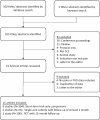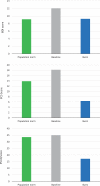Burst Spinal Cord Stimulation: A Systematic Review and Pooled Analysis of Real-World Evidence and Outcomes Data
- PMID: 31152177
- PMCID: PMC6544549
- DOI: 10.1093/pm/pnz046
Burst Spinal Cord Stimulation: A Systematic Review and Pooled Analysis of Real-World Evidence and Outcomes Data
Abstract
Objective: This review provides a comprehensive assessment of the effectiveness of burst spinal cord stimulation (SCS). Ratings of pain intensity (visual analog scale or numeric rating scale) and patient-reported outcomes (PROs) on functional/psychometric domains such as depression (Beck Depression Index), catastrophizing (Pain Catastrophizing Scale), surveillance (Pain Vigilance and Attention Questionnaire), and others are addressed.
Design: Articles were identified and selected from the literature according to prospective, replicable methods. Effectiveness data-pain scores and PRO ratings-were weighted by study sample sizes and pooled. The effects of burst SCS were compared against values at baseline and with tonic SCS. For PROs, published population norms were used for comparison.
Results: Fifteen articles, with a combined sample size of 427, were included. Follow-up ranged from a few hours to two years. A variety of prospective designs were employed, including crossover studies, single-arm cohorts, and a randomized controlled trial, as well as retrospective case reports. The weighted pooled mean pain rating across articles at baseline was 76.7 (±27.4). With tonic SCS, this was reduced to 49.2 (±12.9), and with burst SCS it was further reduced to 36.7 (±11.6), a 12.5-point difference between tonic and burst values. Psychometric analyses of PROs noted preferential improvement with burst SCS. In addition, 65% of subjects stated a preference for burst SCS.
Conclusions: In pooled analyses that incorporated all available published evidence, the improvement over baseline for burst SCS was shown to have a clinically important incremental benefit over tonic SCS. In addition, burst SCS may support resolution of the emotional or cognitive aspects of pain that are mediated by medial thalamo-cortical pathways. This study highlights the value in considering the entire knowledge base in therapeutic assessments as well as adopting a consistent set of outcome variables within neuromodulation. Burst SCS is a valuable intervention, providing both analgesia and psychometric benefits that warrant further thoughtful applications.
Keywords: Affective and Medial Pathway; Burst Stimulation; Chronic Pain; Depression; Neuromodulation; Pooled Analysis; Spinal Cord Stimulation.
© 2019 American Academy of Pain Medicine.
Figures






References
-
- De Ridder D, Vanneste S, Plazier M, Van Der Loo E, Menovsky T.. Burst spinal cord stimulation: Toward paresthesia-free pain suppression. Neurosurgery 2010;665:986–90. - PubMed
-
- Miller JP, Eldabe S, Buchser E, et al. Parameters of spinal cord stimulation and their role in electrical charge delivery: A review. Neuromodulation 2016;194:373–84. - PubMed
-
- Chakravarthy K, Kent AR, Raza A, Xing F, Kinfe TM.. Burst spinal cord stimulation: Review of preclinical studies and comments on clinical outcomes. Neuromodulation 2018;215:431–9. - PubMed
-
- Deer TR, Campos LW, Pope JE.. Evaluation of Abbott’s BurstDR stimulation device for the treatment of chronic pain. Exp Rev Med Dev 2017;146:417–22. - PubMed
Publication types
MeSH terms
LinkOut - more resources
Full Text Sources
Medical
Miscellaneous

